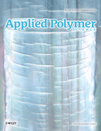Kinetics of glycolysis of poly(ethylene terephthalate) under microwave irradiation
Abstract
The glycolysis of poly(ethylene terephthalate) (PET) was carried out using excess ethylene glycol (EG) in the presence of zinc acetate as catalysts under microwave irradiation. The effects of particle size, microwave power, the weight ratio of EG to PET, the weight ratio of catalyst to PET, reaction temperature and stirring speed on the yield of bis(hydroxyethyl terephthalate)(BHET) were investigated. The experimental results indicated that the glycolysis rate was significantly influenced by stirring speed and initial particle size. The optimal parameters of glycolysis reactions were the weight ratio of catalyst to PET of 1%, the weight ratio of EG to PET of 5, 500 W and 196°C, the yield of BHET reached to 78% at only 35 min. The glycolysis products were analyzed and identified by FTIR, differential scanning calorimetry, and elemental analysis. The kinetics of glycolysis of PET under microwave irradiation could be interpreted by the shrinking core model of the film diffusion control. The apparent activation energy was evaluated using the Arrhenius equation and it was found to be 36.5 KJ/mol, which was lower compared to the same process using conventional heating. The experimental results also showed that the reaction time was significantly decreased under microwave irradiation as compared with it by conventional heating. © 2012 Wiley Periodicals, Inc. J. Appl. Polym. Sci., 2013




